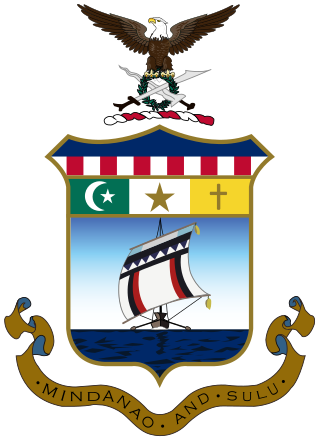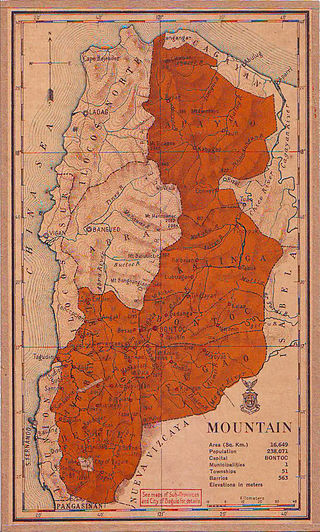
The legislative district of Mindanao and Sulu was the collective representation of the Department of Mindanao and Sulu and its component provinces of Agusan, Bukidnon, Cotabato, Davao, Lanao, Sulu and Zamboanga as a single at-large district in the lower house of the Philippine Legislature from 1916 until 1935.
The legislative district of San Juan–Mandaluyong was the combined representation of the Metropolitan Manila municipalities of Mandaluyong and San Juan in the Regular Batasang Pambansa (1984–1986) and the lower house of the Congress of the Philippines (1987–1995).

The legislative districts of Cebu are the representations of the province of Cebu in the various national legislatures of the Philippines. At present, the province is currently represented in the House of Representatives of the Philippines by its seven congressional districts, with their respective representatives being elected every three years. Locally, the districts are also allotted two seats in the Cebu Provincial Board, with board members also being elected every three years.
The legislative districts of Aurora are the representations of the province of Aurora in the various national legislatures of the Philippines. The province is currently represented in the lower house of the Congress of the Philippines through its lone congressional district.
The Interim Batasang Pambansa was the legislature of the Republic of the Philippines from its inauguration on June 12, 1978, to June 5, 1984. It served as a transitional legislative body mandated by the 1973 Constitution as the Philippines shifted from a presidential to a semi-presidential form of government.
The legislative districts of Benguet are the representations of the province of Benguet in the various national legislatures of the Philippines. The province is currently represented in the lower house of the Congress of the Philippines through its lone congressional district.
The legislative district of Kalinga-Apayao was the representation of the historical province of Kalinga-Apayao in the various national legislatures of the Philippines. Since 1998, the province has been represented in the lower house of the Congress of the Philippines through the separate lone congressional districts of Apayao and Kalinga.
The legislative districts of Ifugao are the representations of the province of Ifugao in the various national legislatures of the Philippines. The province is currently represented in the lower house of the Congress of the Philippines through its lone congressional district.

The legislative districts of Ilocos Sur are the representations of the province of Ilocos Sur in the various national legislatures of the Philippines. The province is currently represented in the lower house of the Congress of the Philippines through its first and second congressional districts.
The legislative districts of Mountain Province are the representations of Mountain Province in the various national legislatures of the Philippines. The province is currently represented in the lower house of the Congress of the Philippines through its lone congressional district.
The Legislative district of Las Piñas–Parañaque was the combined representation of the Metropolitan Manila municipalities of Las Piñas and Parañaque in the Regular Batasang Pambansa from 1984 to 1986.
The Legislative district of Taguig–Pateros–Muntinlupa was the combined representation of the Metropolitan Manila municipalities of Muntinlupa, Pateros and Taguig in the Regular Batasang Pambansa from 1984 to 1986.
The Legislative district of Malabon–Navotas–Valenzuela was the combined representation of the Metropolitan Manila municipalities of Malabon, Navotas and Valenzuela in the Regular Batasang Pambansa from 1984 to 1986.
The Legislative district of Pasig–Marikina was the combined representation of the Metropolitan Manila municipalities of Pasig and Marikina in the Regular Batasang Pambansa from 1984 to 1986.
The legislative districts of Cebu City are the representations of the highly urbanized city of Cebu in the various national legislatures of the Philippines. The city is currently represented in the lower house of the Congress of the Philippines through its first and second congressional districts.
The legislative districts of Davao City are the representations of the highly urbanized city of Davao in the various national legislatures of the Philippines. The city is currently represented in the lower house of the Congress of the Philippines through its first, second, and third congressional districts.
The legislative districts of Sulu are the representations of the province of Sulu in the various national legislatures of the Philippines. The province is currently represented in the lower house of the Congress of the Philippines through its first and second congressional districts.
The legislative districts of Cotabato are the representations of the province of Cotabato in the various national legislatures of the Philippines. The province is currently represented in the lower house of the Congress of the Philippines through its first, second, and third congressional districts.
The legislative districts of Cagayan are the representations of the province of Cagayan in the various national legislatures of the Philippines. The province is currently represented in the lower house of the Congress of the Philippines through its first, second, and third congressional districts.

The sub-provinces of the Philippines were a political and administrative division of the Philippines. The sub-provinces were a part of a larger "regular" province and residents of a sub-province participated in provincial elections of the parent province.





